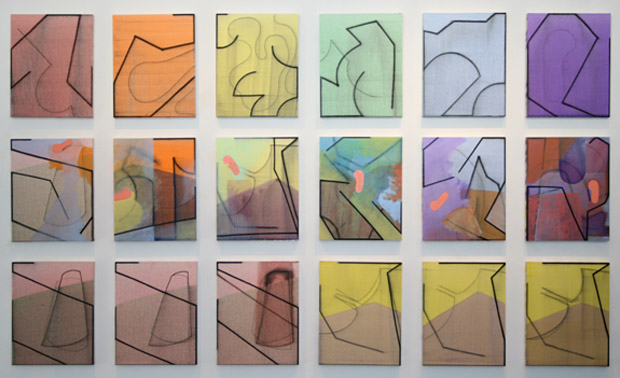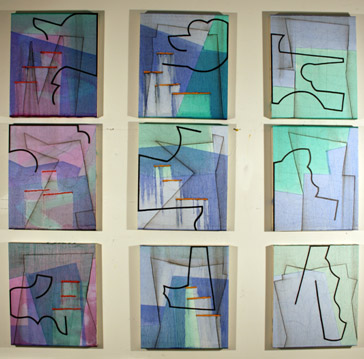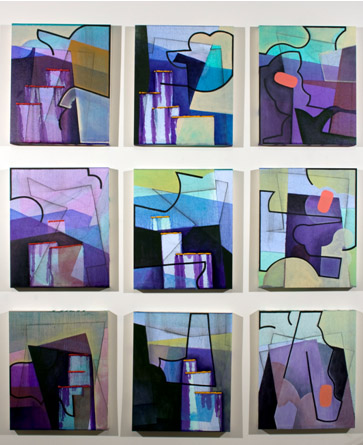The Studio Visit/Progress?
In part this train of thought began after the umpteenth time a studio visit ended with someone saying something like, “It really looks like you’re getting somewhere now…I really think this new work is a leap forward, etc…” I don’t want to go anywhere; I want where I am to be vivid, engaging and full of interesting problems to address. This is true in my painting; this is true in my life.
Studio visits come in many forms with many results. All visits begin with anxious anticipation, no matter who it is visiting it throws off my day, I am restless and anticipatory, setting things right, unable to work, attuned to visual details. A major museum curator or a casual friend can evoke the same anxiety. The anxiety focuses the attention and moves the event to a higher level. What am I looking for? I think I’m hoping to be seen, I’m hoping that this meeting with another mind, another set of eyes will grant encouragement. Something will be seen that I perhaps had not noticed and permission will thus be given to pursue that thread. I remember one key visit when the visitor admired the current work but then asked about some drawings that were off to the side. He said something to the extent that the current work was solid, deeply engaged in painterly issues and rich with reference to the traditions of European painting. But these drawings are something he’d not seen before, a new vocabulary, a language that borrowed and referenced other new things he’d recently seen and thus they intrigued. I had been excited about those new drawings, my desire moved towards them, and yet I felt that they were insubstantial. Within that insubstantiality apparently there lived an opening where he could get in. My subsequent ten years of work developed out of that conversation.
On the other hand my best friend often visits and leaves me feeling angry and bereft. He seems to feel the need to help me. He dwells on his hesitations, the visit becomes about him. Is there a responsibility one carries in being a studio visitor? I think a good studio visit truly takes work; it’s a performance on both sides wherein there is an expectation of engagement. I do a number of studio visits as an MFA artist/teacher/mentor. This is a paid professional role where clearly the expectations are higher. Within that role I work to dig in and find a point of contact with the work, I work to find questions that will both illuminate and challenge. The artist being visited also has an important role to perform. I feel that any good visit must be grounded in questions, what questions are the work addressing, how are they being addressed?
Below is a series from late last fall. The top row was done first, was intended to be a first layer that would then develop. I liked it so I did another row much the same way. I then decided that I now had two good rows so I could afford to move further with the second group. Before I did that I excerpted the first and third paintings from row 2 and copied the drawing three times, thus the third row. Finally I took the second row through many further stages. I realized that the entire process had finally arrived at a project I had long envisioned…how to question the making of a finished painting.

Progress? 2011 18 panels, 20 x 16 inches each, oil, graphite and charcoal
This group of paintings was the basis for an exhibit I curated at Marlboro College where I was serving as a Visiting Professor in the Fall of 2011. The exhibition was entitled Progress? and asked the following question: As artists we are often asked to consider progress while simultaneously and theoretically disbelieving it. It begins in school…with critiques seeking to endlessly better the work, move the work, take it further. In a simple sense one might simply accept that the idea of progress and the impossibility of it coexist.
Painting against progress: The vision of painting I carry is of a much-diminished activity (in terms of contemporary cultural weight) that has within it the potential to play and re-play profoundly interesting acts. This is also, in parallel, the vision I carry for how to live, free of grand designs. I also take into consideration the double meaning of the word, against: it refers to both an oppositional stance and a leaning into. I acknowledge that the possibility and desire to progress is ever present despite its likely impossibility and fatal outcomes.
First, let’s consider life. The progress question can be viewed through many lenses but two that are interesting to consider and relevant to real world problems are the lenses of modernism vs. postmodernism, and the lens of sustainability (in reference to our planet). Sustainability: our love of progress has served us well in bringing extraordinary opportunity and comfort to our lives. It cannot continue this way; there are demonstrable limits to growth. As a culture we will be forced to reconsider and redesign what progress might mean. In terms of modernism, progress was the base assumption of modernity. Progress was inherent in the notion that we might move in a steadily upward direction towards perfectible social systems.
I’ve just finished reading The Glass Room by Simon Mawer. The entire book is a novelistic consideration of modernism. Here the author is speaking of a young Czech in the 1960s, “Her naivety amused him. She was brisk and energetic at her job, fragile and sylph-like in her dancing or in his arms, and credulous in her dealings with the world. She believed in progress. She thought the Party had the best interests of the people at heart. She thought that the future would exist and it would be better that the present; and that the past had existed and it was worse. She thought that there was meaning in life.”
The collapse and devastation of modernism’s two major forces, communism and fascism, have led to the development of post-modernist ideas. The fundamental assumption of post-modernism is the replacement of the image of vertical progress with the acceptance of horizontal attention. Progress has become culturally undesirable; instead we must look to our present world and love it.
A Lamentation
In abstraction the question has always been, when is it done?
Within the series of paintings that I am currently working I am investigating this question. I have undertaken to work in groups of nine small (20 x16 inches) small panels. Each group is worked through in stages…first some drawing, then washes of paint to both fix and move the charcoal, then more drawing, then more washes, etc. The same activities done to several paintings allow me to try out variations within a limited range. The number of givens makes for a rich mix of formal order and improvisation. Below are two images of a set that I’ve titled Montaigne. In a recent studio visit I was discussing this group with a friend and he thought it was (in comparison with other groupings) the weakest, too closed up and over-realized. This led me to dig up an image of the paintings at an earlier stage, a stage I had liked very much but I had grown wary of in some way. I suppose it was the recurring ache of insufficiency. At any rate I finally determined to try excess rather than my habitual minimalism. I mourn the loss of those earlier paintings. I am considering an installation wherein I would hang the nine panels in their late state next to nine equally sized photo images mounted on similar panels of the paintings in their early state.

Montaigne: from June 2011

Montaigne: December 2011
Finally, a very recent visit resulted in this note, “These paintings may feel out of your comfort zone, but they read as very confident works. The thing I find most interesting is your ability to build the painting/drawing to a place where you trust you can exit. Some of us build and destroy then build and destroy again in almost endless cycles, never trusting the countless times the painting is finished. But you have the confidence to build until you strike a note that resonates and trust it. I imagine working as a grouped series helps because it allows you to explore all the ‘what ifs’ without fucking up on a single painting over and over.”
This recognition of the notion that my developing methodology provides the access to a “trusted exit” has truly offered fresh and encouraging insight. I had hoped for this outcome but not seen it. And this initiates a flood of desire to carry on.
Craig Stockwell, 2012
craigstockwell.com
